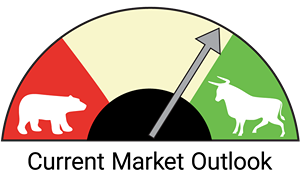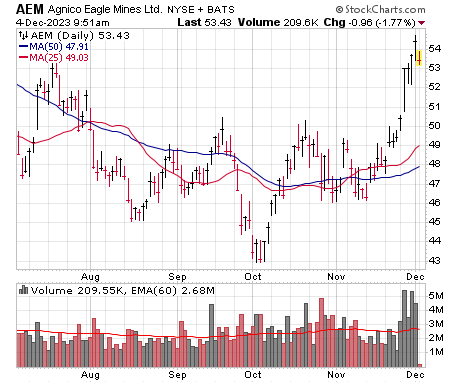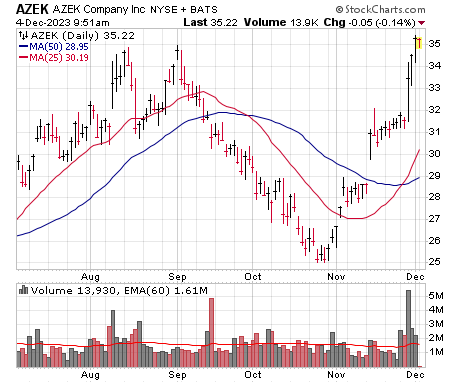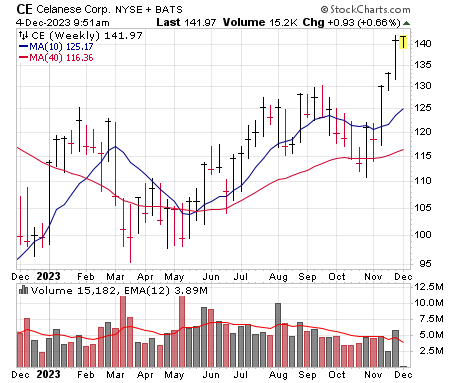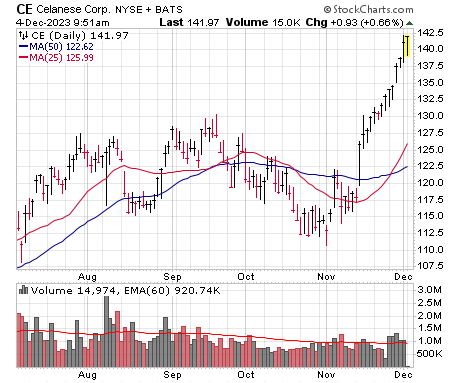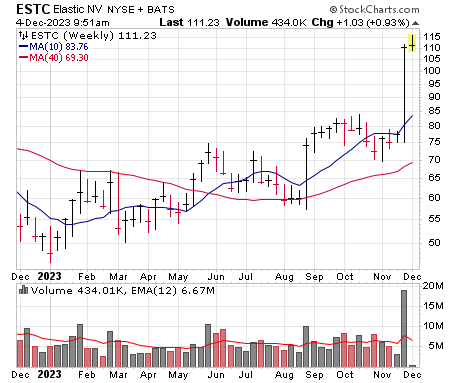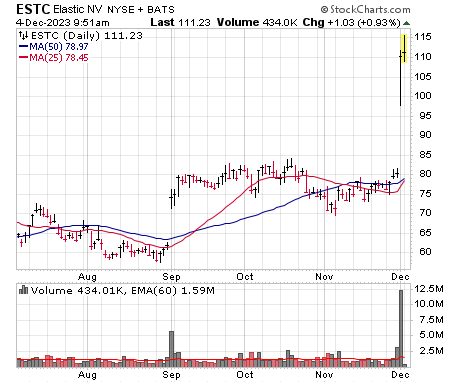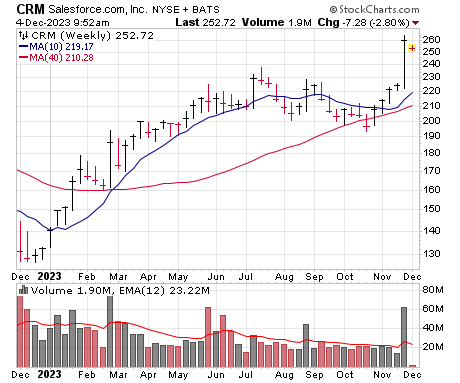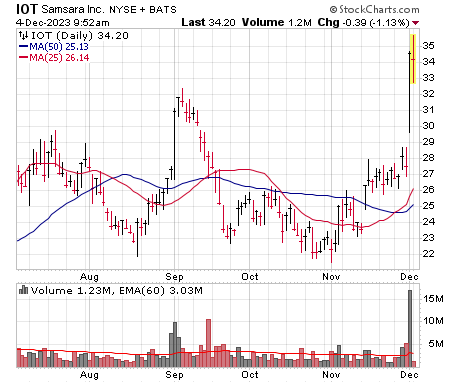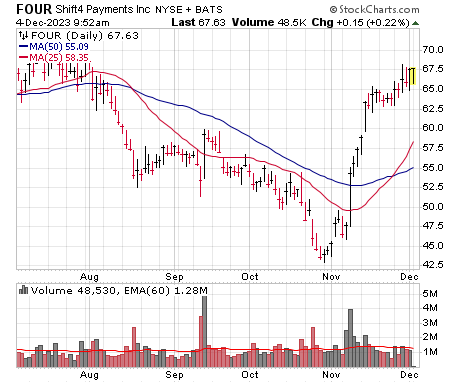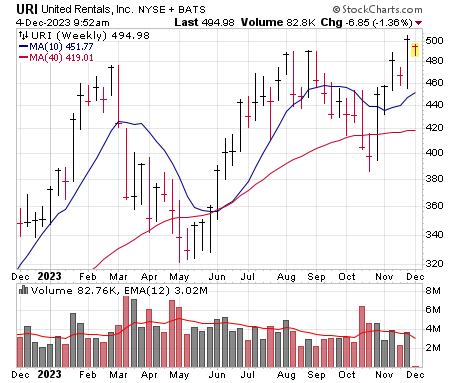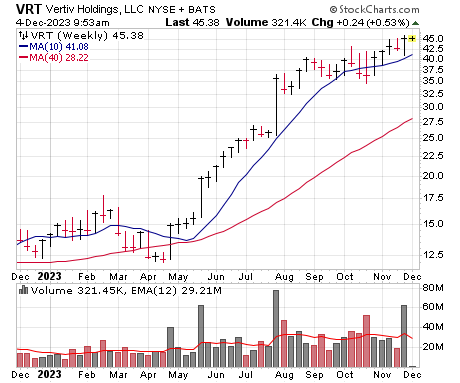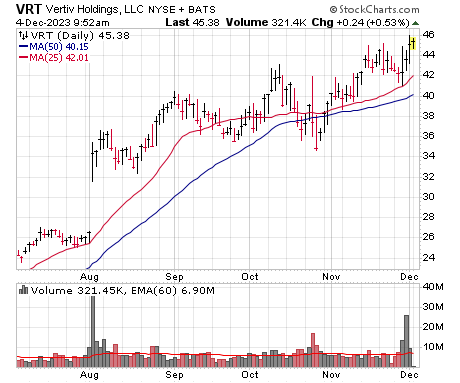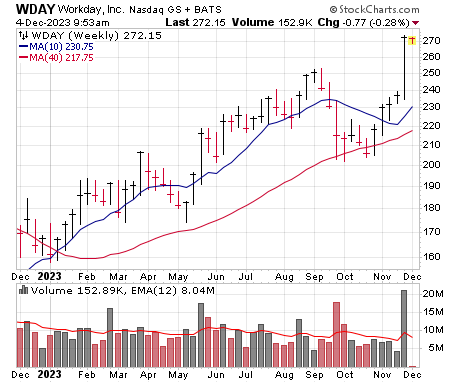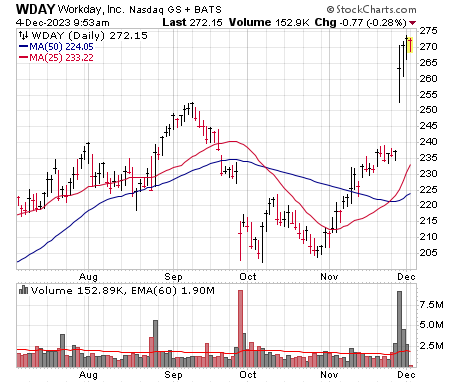Intermediate-Term Evidence Solid—Short-Term Wobbles Possible
Most of the rubber-meets-the-road evidence is positive when it comes to the intermediate-term, with bullish trends in the indexes and most stocks, a growing number of new highs and leading individual stocks acting as they “should.” That said, short-term, some wobbles and rotation are beginning to creep in—some growth areas (like chips) are weakening while the broad market (small-caps, etc.) are perking up, and after five weeks of strong gains, investor sentiment has gotten a bit comfortable (seen partly via many “junk” stocks popping higher, which often precedes a pullback). That doesn’t have us growing more cautious, and in fact, we’re bumping up our Market Monitor to a level 7—though we are still favoring moving gradually and picking your stocks and entry points carefully. These days, that means ideally entering on at least modest dips as we see how this rest/rotation plays out.
This week’s list has another nice collection of stocks, including everything from precious metals to chemicals to some powerful earnings gaps in the tech space. Our Top Pick is Vertiv Holdings (VRT), which isn’t early in its run, but after a choppy three months, it appears ready for its next move.
Price |
| Agnico Eagle Mines (AEM) |
| Azek (AZEK) |
| Celenese (CE) |
| Elastic (ESTC) |
| Salesforce.com (CRM) |
| Samsara (IOT) |
| Shift4 Payments (FOUR) |
| United Rentals (URI) |
| Vertiv Holdings (VRT) ★ Top Pick ★ |
| Workday (WDAY) |
Stock 1
Agnico Eagle Mines (AEM)
Price |
Why the Strength
After a shaky past few months, gold has taken flight on the back of a big improvement in the precious metal’s fundamental backdrop, which includes a weaker U.S. dollar, falling Treasury yields and increased safe-haven demand from the world’s many uncertainties. One of the highest-quality players in the gold arena is Agnico, a senior Canadian producer with a pipeline of lucrative exploration and development projects in the U.S., Canada, Mexico and Columbia. Key to Agnico’s long-term growth plans is its 100% owned Canadian Malartic mine, which is being transformed from Canada’s second-largest operating gold mine to its largest underground mine, with 15 million ounces of resources being added to its future potential just since 2019. Another major contributor to Agnico’s expansion efforts is the open-pit Meadowbank complex in Canada, which has seen a 15% year-on-year increase in gold production in the first nine months of this year along with record haulage of underground ore in Q3—and there have also been efforts to extend the mine’s life by several years. Agnico described overall Q3 production across its mine portfolio as “robust,” with gold production coming in above the mid-point of annual guidance and cost performance remaining “solid,” though margins have fallen off. Payable gold production in Q3 was over 850,000 ounces at production costs per ounce of $893 and with all-in sustaining costs (a key metric) of $1,210 per ounce—well under the current gold price of ~$2,100 and leaving Agnico in a strong position to benefit from additional upside in gold, which will fall right to the bottom line. Q3 revenue of $1.6 billion jumped 13%, while EPS of 44 cents was in-line with estimates. The the firm ended the quarter in a flexible financial position with $355 million in cash and over $1 billion in available liquidity, which should help Agnico’s expansion plans going forward along with dividend payments (a 2.9% yield). Wall Street sees earnings growth 13% next year, but that will obviously be conservative if gold’s rally gets legs.
Technical Analysis
AEM hit a 12-month high in early May but then succumbed to selling pressure for the next few months as gold prices faded. The stock had a brief shakeout below support near 44 in October before quickly turning around, snapping back to 50 and then spending a few weeks tightening up. And now we see the stock pushing higher on a nice cluster of buying volume last week. We’re OK nabbing some here or on a dip of a point or so, with a stop under round-number resistance of 50.
| Market Cap | $26.9B | EPS $ Annual (Dec) | ||
| Forward P/E | 23 | FY 2021 | 2.48 | |
| Current P/E | 26 | FY 2022 | 2.31 | |
| Annual Revenue | $6.25B | FY 2023e | 2.08 | |
| Profit Margin | 13.4% | FY 2024e | 2.35 | |
| Qtrly Rev | Qtrly Rev Growth | Qtrly EPS | Qtrly EPS Growth | |
| ($B) | (vs. yr-ago-qtr) | ($) | (vs. yr-ago-qtr) | |
| Latest qtr | 1.64 | 13% | 0.44 | -10% |
| One qtr ago | 1.72 | 9% | 0.65 | -18% |
| Two qtrs ago | 1.51 | 14% | 0.57 | -11% |
| Three qtrs ago | 1.38 | 46% | 0.41 | -11% |
Weekly Chart | Daily Chart |
Stock 2
Azek (AZEK)
Price |
Why the Strength
Building products maker Azek handily beat expectations for its 2023 fiscal Q4 reported last week. Sales were up 28% from a year ago, to $389 million, while net income more than doubled to 36 cents per share, both stronger than expected. Azek makes exterior building products, including the TimberTech decking line and the Azek Trim line for home builders and DIY repairs. Its products are composite, made mostly of recycled plastics, like grocery store bags. The end products are highly durable, moisture resistant and come in a range of wood-like colors. Homeowners like composite material because, while more expensive, they never need to be painted like wood decking and the trim doesn’t rot out. Outdoor decking is the number one remodel project homeowners take on, which helped push residential sales up 36% for Azek. The upfront cost is more than wood, which makes selling cost-conscious homebuilders on using composite more difficult, but the segment continues to grab share from wood products nonetheless based on lower lifetime costs. Contractors increasingly see advantages in labor-saving product lines like Azek’s PaintPro line, which are composite boards designed to be painted without pre-treating while drying faster than other options. Sales-wise, beating last year was fairly easy – that was a down year for residential construction – thought next year presents a higher hurdle. But Azek shows signs of strength, including widening margins and an eight-week backlog of contractor orders, a return to its historical norm. Management is a bit conservative with its outlook, but Wall Street thinks the bottom line can ramp nearly 20% next year, and if the economy stays strong, that could prove too low.
Technical Analysis
After imploding with all building and housing stocks for much of 2022, AZEK had a solid run from October of last year until this summer. But then things got ugly, with shares falling 28% in a straight line, down eight weeks in a row and briefly dipping back below the 40-week line. However, shares turned on a dime with the market, rallying five weeks in a row and then enjoying a huge-volume rally back to its August highs after earnings. Dips would be tempting.
| Market Cap | $5.30B | EPS $ Annual (Sep) | ||
| Forward P/E | 36 | FY 2022 | 0.97 | |
| Current P/E | 46 | FY 2023 | 0.74 | |
| Annual Revenue | $1.37B | FY 2024e | 0.99 | |
| Profit Margin | 13.8% | FY 2025e | 1.16 | |
| Qtrly Rev | Qtrly Rev Growth | Qtrly EPS | Qtrly EPS Growth | |
| ($M) | (vs. yr-ago-qtr) | ($) | (vs. yr-ago-qtr) | |
| Latest qtr | 389 | 28% | 0.36 | 125% |
| One qtr ago | 388 | -2% | 0.30 | 3% |
| Two qtrs ago | 378 | -5% | 0.18 | -45% |
| Three qtrs ago | 216 | -17% | -0.09 | N/A |
Weekly Chart | Daily Chart |
Stock 3
Celenese (CE)
Price |
Why the Strength
Celanese is a leading global provider of acetyl products (used in paints, adhesives and textiles) and other specialty materials used in most major industries and consumer applications. A major reason for its recent strength is the company’s exposure to growth markets like electric vehicles (EVs), electrical infrastructure and alternative energy in general. The company’s nylon polymer PA66, for instance, is used in engineering resins and has wide applications in EV and hybrid vehicle production. Celanese is seeing higher PA66 demand for use in battery cell frames and high-voltage connector, brackets and mounts for electric motors. What’s more, the company expects overall electricity demand to more than double in the next five years as part of the “electrification of everything” trend, which it sees boding very well for PA66 demand (used heavily by firms that are building out electrical infrastructure). But the company isn’t hanging its hat solely on the energy transition and is seeing increased demand for its materials solutions pertaining to the medical, pharmaceutical and food industries. On the latter front, Celanese just completed the formation of Nutrinova, a food ingredients joint venture with Mitsui & Co. focused on sweeteners and preservatives. Several additional recent acquisitions, including Exxon Mobil’s Santoprene thermoplastics business, have broadened the firm’s engineered solutions portfolio and are expected to increase earnings in the coming years, and Celanese has implemented a number of cost reduction efforts which the firm sees boosting margins going forward. After a boomlet during the post-pandemic period, earnings are coming back down to earth—Q3 saw the bottom line down 27% from a year ago—but they remain elevated ($9 per share this year) and Wall Street sees alternate energy catalysts and a general firming of demand and pricing contributing to a great rebound next year.
Technical Analysis
CE sold off heavily during last year’s bear market, with shares being cut nearly in half, before rebounding to nearly 130 in early February. But that began a long basing period, with the stock range bound between 100 and 130 (give or take) for many months. However, after shaking down to the 40-week line in October, CE has changed character, with solid support after earnings and, more recently, pushing to higher highs. We’ll set our buy range down a couple of points, thinking a normal exhale is likely.
| Market Cap | $15.4B | EPS $ Annual (Dec) | ||
| Forward P/E | 16 | FY 2021 | 18.13 | |
| Current P/E | 17 | FY 2022 | 15.88 | |
| Annual Revenue | $10.7B | FY 2023e | 9.01 | |
| Profit Margin | 10.1% | FY 2024e | 11.95 | |
| Qtrly Rev | Qtrly Rev Growth | Qtrly EPS | Qtrly EPS Growth | |
| ($B) | (vs. yr-ago-qtr) | ($) | (vs. yr-ago-qtr) | |
| Latest qtr | 2.72 | 18% | 2.50 | -37% |
| One qtr ago | 2.80 | 12% | 2.17 | -57% |
| Two qtrs ago | 2.85 | 12% | 2.01 | -64% |
| Three qtrs ago | 2.35 | 3% | 1.44 | -71% |
Weekly Chart | Daily Chart |
Stock 4
Elastic (ESTC)
Price |
Why the Strength
Elastic is the Google of Big Data—it’s effectively a search company, but instead of mining the internet for content, it’s used by tons of big enterprises (Microsoft, Home Depot, Booking.com, Adobe, Uber and many others) to ingest massive amounts of any type of data (text, numbers, structured or unstructured, even stuff like geospatial), securely store it and then quickly and effectively search it to get actionable insights. In the firm’s words, it allows clients to find answers that matter from all data, in real time and at scale; right now, it’s big in observability (IT teams can search for relevant data on how systems are performing, including whether they’re working together) and security (searching for threats), and with increased cloud adoption (Elastic’s cloud revenue was up 31% in Q3, nearly twice overall revenue growth), it’s leading to very solid results, as you can see in the table below. All of that is to the good and should keep growth humming, but big investors seem to be betting that an acceleration is possible thanks to AI: Simply put, Elastic’s various offerings are tailor made for the new AI reality, giving clients the tools to build AI-powered search applications that integrate with their own large language model, or use Elastic’s own semantic language model, which lets them get up and running quickly. (The top brass said there was a huge pickup in interest in these offerings in Q3.) To be fair, management also said it will take time for AI-related efforts to really impact the numbers here, but the market seems to be discounting the fact that Elastic will be a key cog in tons of AI efforts going ahead. All told, it’s a solid growth story with plenty of potential for acceleration within a few quarters.
Technical Analysis
ESTC fell from 190 to the 50 area during the bear market, and as opposed to other tech peers, it really didn’t kick into gear this spring—in fact, at the end of August, it was still hanging around just under 60. But the early-September quarterly report got things moving, and after a reasonable five-week consolidation, ESTC absolutely went bananas last Friday, soaring on its highest-ever daily volume as the stock hit 23-month highs. Given the move, volatility will be extreme, but we’re OK with a small position here or on a dip.
| Market Cap | $10.9B | EPS $ Annual (Apr) | ||
| Forward P/E | 97 | FY 2022 | -0.33 | |
| Current P/E | 80 | FY 2023 | 0.25 | |
| Annual Revenue | $1.16B | FY 2024e | 1.14 | |
| Profit Margin | 12.3% | FY 2025e | 1.54 | |
| Qtrly Rev | Qtrly Rev Growth | Qtrly EPS | Qtrly EPS Growth | |
| ($M) | (vs. yr-ago-qtr) | ($) | (vs. yr-ago-qtr) | |
| Latest qtr | 311 | 17% | 0.37 | 999% |
| One qtr ago | 294 | 17% | 0.25 | N/A |
| Two qtrs ago | 280 | 17% | 0.22 | N/A |
| Three qtrs ago | 275 | 23% | 0.17 | N/A |
Weekly Chart | Daily Chart |
Stock 5
Salesforce.com (CRM)
Price |
Why the Strength
As the digital and artificial intelligence (AI) transition trends accelerate, more and more companies need assistance in seamlessly integrating and monetizing data from multiple sources. That’s where blue chip Salesforce comes into play: Aside from being a top provider of customer relationship management (CRM) technology and analytics services, the company’s MuleSoft Anypoint data integration platform allows different applications and systems to communicate with each other, making it easier for customers to connect data sources and have them work properly. Of significance, MuleSoft (which the firm bought a few years back) serves as a focal point of Salesforce’s growth strategy and was a big contributor to earnings in Q3, accounting for eight of Salesforce’s top 10 deals in the quarter and delivering 140 billion automated flows (up 142% year-on-year). On that score, the company saw massive growth of 80% in deals of more than $1 million in Q3, which contributed to an 11% jump in total revenue of $8.7 billion and a 51% increase in earnings of $2.11 a share (reasons for the stock’s strength). The quarter also saw Salesforce become the third largest enterprise software company by revenue, the number one AI CRM and the number one enterprise apps firm. Further contributing to the company’s Q3 momentum was its collaborate workspace Slack business, which was included in seven of its top 10 deals and is a major component of Salesforce’s integration with generative AI. Other financial tidings were equally impressive, including a backlog of $24 billion (up 13%) and a giant leap in free cash flow “opening up and likely in the early innings” (in the words of a major Wall Street bank). It’s not the young buck it was once, but Salesforce should have plenty of growth and big cash flow ahead.
Technical Analysis
CRM experienced a massive hangover from the heady days of the pandemic era, peaking in late 2021 at 310 and free-falling for the next year before bottoming at 125. But this year’s calendar flip year saw a change of fortunes as CRM launched a new bull, with shares rising steadily for seven months before hitting resistance this summer at 240. A multi-month correction followed, which was reversed at the 40-week line in late October—and after a modest rally, earnings last week shot CRM to 23-month highs on a couple of days of massive volume. We’re OK buying on today’s weakness or on further dips.
| Market Cap | $253B | EPS $ Annual (Jan) | ||
| Forward P/E | 29 | FY 2022 | 4.78 | |
| Current P/E | 33 | FY 2023 | 5.24 | |
| Annual Revenue | $34.0B | FY 2024e | 8.17 | |
| Profit Margin | 23.7% | FY 2025e | 8.88 | |
| Qtrly Rev | Qtrly Rev Growth | Qtrly EPS | Qtrly EPS Growth | |
| ($B) | (vs. yr-ago-qtr) | ($) | (vs. yr-ago-qtr) | |
| Latest qtr | 8.72 | 11% | 2.11 | 51% |
| One qtr ago | 8.60 | 11% | 2.12 | 78% |
| Two qtrs ago | 8.25 | 11% | 1.69 | 72% |
| Three qtrs ago | 8.38 | 14% | 1.68 | 100% |
Weekly Chart | Daily Chart |
Stock 6
Samsara (IOT)
Price |
Why the Strength
Samsara’s story oozes rapid, reliable and a long runway of growth (which we simply call the 3Rs of stock picking), and chart-wise, we’re thinking the third time might be the charm in terms of a breakout. The firm’s claim to fame is its cloud software platform for clients’ physical assets, providing vehicle telematics, video-based safety, safety training, equipment monitoring (including preemptive servicing and not waiting for something to go kaput) and the like, and it’s moving into new fields like connected forms (digitizing standardized forms like incident reports), all of which boost efficiencies and lower costs (including insurance costs via the safety offerings). The market here is enormous, with at least four of the largest 10 waste management, construction, less-than-truckload transport firms, chemical carriers and grocery firms as current clients, and most are upping their purchases in a big way over time as the savings are massive. (One big airline is saving $15 million a year on fuel and better utilization of its ground fleet!) Indeed, in Q3, Samsara’s annualized recurring revenue surpassed $1 billion (up 39%), thanks in large part to a 49% gain in $100k-plus customers (1,663 total), including 71 that now pay the company at least $1 million a year, while Samsara is expanding into many new nooks and crannies (17% of new bookings were international in the quarter; 87% came from non-transportation outfits). And with huge data-related barriers to entry—the firm has six trillion data points on various pieces of equipment to know better what works best to boost efficiency—it’s unlikely there will be any major competition in this specialized field. From here, it’s just a matter of selling current clients more modules while signing up more heavyweights, as well as launching new products. The valuation here is definitely nosebleed-ish (about 18.5x run-rate revenues) and sponsorship is just so-so (335 funds own shares), but there’s no question the potential is huge.
Technical Analysis
IOT hit 31 three weeks after coming public in 2021, fell to 9 in late 2022, and then rebounded all the way back to 30 by June of this year. But that kicked off a very volatile few months, with the stock gyrating up and down a couple of times between 22 and 32. Sure, maybe it fails again, but it’s also possible that, with a more supportive overall market, the third attack of this area will work—after rallying decently with the market in November, IOT’s gap last Friday left it at new all-time price and relative performance (RP) peaks. We’ll set our entry range down a bit, with a loose loss limit in case shares wobble.
| Market Cap | $18.5B | EPS $ Annual (Jan) | ||
| Forward P/E | 999 | FY 2022 | -0.23 | |
| Current P/E | 999 | FY 2023 | -0.13 | |
| Annual Revenue | $848M | FY 2024e | 0.05 | |
| Profit Margin | 9.2% | FY 2025e | 0.08 | |
| Qtrly Rev | Qtrly Rev Growth | Qtrly EPS | Qtrly EPS Growth | |
| ($M) | (vs. yr-ago-qtr) | ($) | (vs. yr-ago-qtr) | |
| Latest qtr | 238 | 40% | 0.04 | N/A |
| One qtr ago | 219 | 43% | 0.01 | N/A |
| Two qtrs ago | 204 | 43% | -0.02 | N/A |
| Three qtrs ago | 187 | 48% | -0.02 | N/A |
Weekly Chart | Daily Chart |
Stock 7
Shift4 Payments (FOUR)
Price |
Why the Strength
Shift4 has had a great story for many quarters, and now that the market is in a much better mood, we’re thinking the stock will begin to really reflect it. The company looks like a new payment leader (which is a constant theme through market cycles), with a comprehensive offering that has far lower costs (including recurring costs) than its nearest competitor and seems well-suited to many areas, including clients with many payment points on a broad campus (think stadiums or golf courses). Throw in some well-timed M&A and the firm, while only having been public since mid 2020, has a great history (24 straight years of revenue growth) and that continues to this day: Despite a tricky economic environment, Q3 saw the firm’s payment volume lift 36%, revenues less network fees rise 24%, EBITDA rally 46% and earnings soar 123% while free cash flow remains very healthy (should come in north of $3 per share in 2023). The core business here remains hospitality and restaurants, which still make up three-quarters or so of payment volume, and those continue to grow rapidly as Shift4 reportedly takes market share. But even more exciting is Shift4’s move into many newer areas, inking deals with various sports and entertainment outfits (including concession and/or ticketing deals with the 49ers and Dolphins of the NFL and Magic of the NBA), non-profits, “sexy tech” (including the world’s largest online marketplace for timeshare rentals and resales) and more. Even better, Shift4 is inking bigger clients (its average merchant is nearly triple the size seen just two years ago!), and the future is very bright, too, as many deals inked this year just kicked into gear in Q4 and, with the completion of the buyout of Finaro, Shift4 is looking to sign 10,000 European restaurants to its platform in 2024 alone! All told, the firm sees organic payment volume rising 47% next year, which has Wall Street looking for 30%-ish earnings and cash flow growth. This remains a great growth story.
Technical Analysis
FOUR looked like a fresh early leader of the move this year, with some positive relative strength in late 2022 and a solid (albeit herky-jerky) advance into April. But then a short report and a weak market for small caps took its toll—despite great results and outlooks, the stock fell a whopping 44% by Halloween. But the Q3 report has seemingly wiped away all prior bad vibes, with FOUR recouping three months of losses in just three weeks! There is resistance up in this area, so we’d aim to start small here or (preferably) on dips and add to the position if shares can break into the low 70s.
| Market Cap | $5.60B | EPS $ Annual (Dec) | ||
| Forward P/E | 18 | FY 2021 | 0.45 | |
| Current P/E | 24 | FY 2022 | 1.35 | |
| Annual Revenue | $2.40B | FY 2023e | 2.84 | |
| Profit Margin | 8.2% | FY 2024e | 3.68 | |
| Qtrly Rev | Qtrly Rev Growth | Qtrly EPS | Qtrly EPS Growth | |
| ($M) | (vs. yr-ago-qtr) | ($) | (vs. yr-ago-qtr) | |
| Latest qtr | 675 | 23% | 0.96 | 123% |
| One qtr ago | 637 | 26% | 0.89 | 197% |
| Two qtrs ago | 547 | 36% | 0.47 | 31% |
| Three qtrs ago | 538 | 35% | 0.40 | 400% |
Weekly Chart | Daily Chart |
Stock 8
United Rentals (URI)
Price |
Why the Strength
For full-year 2023, spending on U.S. factory construction is forecast to hit a record-breaking $200 billion—up an eye-popping 70% from a year ago—which continues the torrid pace since the boom started in 2021. Pivotal to this trend are various federal subsidies for manufacturers of key industries to build factories, including semiconductor and EV battery producers. All of this directly benefits United Rentals, the market share leader in the North American equipment rentals with a $20 billion fleet consisting of around 4,600 equipment classes used for industrial and non-residential construction. Indeed, analysts see continued investments in microchip, EV and battery plants providing plenty of growth opportunities for United Rentals for years to come. Supporting this outlook was record rental revenue (up 18%) in Q3, which contributed to total sales of $3.8 billion (up 23%). Additionally, per-share earnings of $11.73 beat estimates by 56 cents and free cash flow of $339 million nearly doubled in the quarter (all reasons for the stock’s strength). The company continues to see growth across all the geographic regions it serves, with the non-residential construction rentals business growing 9%, fueled by “numerous” EV- and semiconductor-related jobs, as well as solar power facilities, infrastructure projects, data centers and healthcare facilities. Shareholder returns are a big focus for United Rentals going forward, and the firm returned $350 million in Q3 through buybacks and dividends (1.2% yield) and remains on track to return over $1.4 billion in cash this year (about 4% of the current market cap). Beyond 2023, the top brass sees tailwinds across infrastructure, manufacturing and energy supporting continued “strong” cash flows and long-term expansion. United is one of the ultimate cyclical plays out there, so if the economy remains firm, results should continue to surprise on the upside while more cash flow is used to support shares.
Technical Analysis
URI rallied from its lows last year to 480 this past March before pulling in with the market and beginning what turned out to a huge launching pad: There was a sharp-but-normal 30% correction into May, a rally back to the 490 to 500 resistance area in August and September and another 21% dip with the market into October. But like many names, URI’s character changed at that point, with shares quickly rallying back to resistance and now trying to push above it. We’ll set our buy range up a bit from here, looking for a clearer breakout.
| Market Cap | $34.0B | EPS $ Annual (Dec) | ||
| Forward P/E | 12 | FY 2021 | 22.06 | |
| Current P/E | 12 | FY 2022 | 32.49 | |
| Annual Revenue | $13.9B | FY 2023e | 40.08 | |
| Profit Margin | 21.3% | FY 2024e | 42.81 | |
| Qtrly Rev | Qtrly Rev Growth | Qtrly EPS | Qtrly EPS Growth | |
| ($B) | (vs. yr-ago-qtr) | ($) | (vs. yr-ago-qtr) | |
| Latest qtr | 3.77 | 23% | 11.73 | 27% |
| One qtr ago | 3.55 | 28% | 9.88 | 26% |
| Two qtrs ago | 3.29 | 30% | 7.95 | 39% |
| Three qtrs ago | 3.30 | 19% | 9.74 | 32% |
Weekly Chart | Daily Chart |
Stock 9
Vertiv Holdings (VRT) ★ Top Pick ★
Price |
Why the Strength
Vertiv offers mission-critical technological infrastructure products like uninterruptable power supplies, computer system thermal management equipment and rack and enclosures for server racks. About three-quarters of its business involves data centers, evenly divided between corporate enterprise set-ups and large server farms that for multiple businesses. Vertiv is a long-established operation, having started just after WWII as one of the first businesses to provide refrigeration to manage the potentially damaging heat generated in computer operations. In a way, past is prologue, since the explosion of AI services (and the more powerful, greater heat-producing chips and equipment they need to operate) is offering Vertiv a route for years of increasing demand. Last week, at an investor conference, management said AI will spark data center growth in the annual 9% to 12% range, up from a baseline growth of 7% it previously projected. The massive computing power AI requires, and the fact AI systems are frequently large server farms, plays well into Vertiv’s large-scale capacity. That has the company expecting its growth rate (not including any M&A) over the next five years can outpace its peers, at 8% to 11%, with expanding margins (20% operating margin target, up from 15% this year) driving earnings up at a much faster rate. In particular, Vertiv’s push further into liquid cooling should help – it announced a deal to buy UK innovator CoolTera today, a firm that designs cooling systems for chips in development in coordination with Intel and NVIDIA. Growth should remain solid in the quarters ahead, with management seeing organic sales growth of around 9% for 2024 while analysts expect earnings to expand 27%--and a $3 billion share buyback program should be a plus, too.
Technical Analysis
It wasn’t until May of this year that VRT really got going, and the advance was stunning, with shares lifting 10 weeks in a row, then eventually gapping up again to all-time highs in August and rallying to 40 later that month. Since then, the stock has been choppy but done nothing wrong, mostly holding the 50-day line, and last week saw a pickup in volume following the analyst day as shares perked to new price and RP highs. We’re OK starting a position here with a stop near 40.
| Market Cap | $17.2B | EPS $ Annual (Dec) | ||
| Forward P/E | 20 | FY 2021 | 0.76 | |
| Current P/E | 29 | FY 2022 | 0.53 | |
| Annual Revenue | $6.64B | FY 2023e | 1.74 | |
| Profit Margin | 11.5% | FY 2024e | 2.21 | |
| Qtrly Rev | Qtrly Rev Growth | Qtrly EPS | Qtrly EPS Growth | |
| ($B) | (vs. yr-ago-qtr) | ($) | (vs. yr-ago-qtr) | |
| Latest qtr | 1.74 | 18% | 0.52 | 126% |
| One qtr ago | 1.73 | 24% | 0.46 | 360% |
| Two qtrs ago | 1.52 | 32% | 0.24 | N/A |
| Three qtrs ago | 1.65 | 17% | 0.28 | 600% |
Weekly Chart | Daily Chart |
Stock 10
Workday (WDAY)
Price |
Why the Strength
Human capital management and financial software specialist Workday (covered in the September 11 issue) wowed Wall Street last week with a blowout earnings report that featured solid subscription growth, prompting several analysts to raise their estimates and price targets. In fiscal Q3 2024 (ended October 31), Workday saw a 17% year-on-year increase in total revenue of $1.9 billion and per-share earnings of $1.53 that beat estimates by 8%. The sanguine results were led by an 18% jump in subscription revenue of $1.7 billion, plus 12-month subscription revenue backlog of $6 billion (up 22%) and 24-month subscription revenue backlog of $10.6 billion (up 23%), which Workday said benefited from increased contract durations and speaks to its clients’ continued commitment to the platform. The company credited the buoyant results to strength in full platform deals, international growth and increased artificial intelligence (AI) innovation, which is part of a strategy to build AI directly into the core of its products and follows significant investments in generative and conversational AI. Management said the latter technology would “fundamentally change” how users interact with Workday by enabling them to easily obtain information they need and interact with data through simple conversation (in turn resulting in quicker, more strategic decisions). The company also touted recent enhancements to its app-building solution Workday Extend, which has seen a 70% increase in the number of apps built by its customers in the past year. Looking ahead, Workday is focused on margin expansion and it hiked subscription guidance for fiscal 2024 to $6.6 billion (up 19% if realized), while also expecting its 12-month backlog for Q4 to grow by the same amount. Analysts see 17%-ish top-line growth for each of the next three years.
Technical Analysis
After peaking at 250 in early September, WDAY began what looked like a normal exhale, only to hit a good-sized air pocket by the end of that month, with shares gapping lower on big volume. The stock hit bottom at 205 by early October though, to its credit, held the 200-day line three different times through most of October as the market fizzled. The rebound through Thanksgiving was solid, but it was last week’s earnings that really was the “go” signal, with a huge-volume move to 23-month highs. We’ll set our buy range down a bit, but we’re not expecting a major retreat.
| Market Cap | $72.0B | EPS $ Annual (Dec) | ||
| Forward P/E | 41 | FY 2022 | 3.99 | |
| Current P/E | 51 | FY 2023 | 3.64 | |
| Annual Revenue | $6.99B | FY 2024e | 5.74 | |
| Profit Margin | 21.9% | FY 2025e | 6.60 | |
| Qtrly Rev | Qtrly Rev Growth | Qtrly EPS | Qtrly EPS Growth | |
| ($B) | (vs. yr-ago-qtr) | ($) | (vs. yr-ago-qtr) | |
| Latest qtr | 1.87 | 17% | 1.53 | 55% |
| One qtr ago | 1.79 | 16% | 1.43 | 72% |
| Two qtrs ago | 1.68 | 17% | 1.31 | 58% |
| Three qtrs ago | 1.65 | 20% | 0.99 | 27% |
Weekly Chart | Daily Chart |
Previously Recommended Stocks
| Date | Stock | Symbol | Top Pick | Original Buy Range | 12/4/23 |
| HOLD | |||||
| 10/23/23 | 555-570 | 605 | |||
| 10/23/23 | 94.5-96.5 | 105 | |||
| 10/16/23 | 214-218 | 236 | |||
| 11/20/23 | 49-51.5 | 57 | |||
| 11/6/23 | 40-41.5 | 46 | |||
| 11/6/23 | 180-184 | 189 | |||
| 9/5/23 | ★ | 161-166 | 237 | ||
| 11/6/23 | 86.5-89 | 98 | |||
| 11/6/23 | ★ | 33-35 | 37 | ||
| 11/13/23 | 202-208 | 217 | |||
| 10/16/23 | ★ | 595-608 | 586 | ||
| 10/30/23 | 207-211 | 231 | |||
| 11/20/23 | 538-554 | 540 | |||
| 10/23/23 | 73.5-76 | 88 | |||
| 11/6/23 | 433-445 | 464 | |||
| 11/20/23 | 76.5-79 | 74 | |||
| 7/10/23 | ★ | 45-47 | 45 | ||
| 9/5/23 | ★ | 33-34.5 | 44 | ||
| 2/27/23 | 225-230 | 455 | |||
| 10/23/23 | 16.5-17.5 | 18 | |||
| 11/6/23 | 29.5-31 | 35 | |||
| 11/20/23 | ★ | 86.5-89 | 91 | ||
| 11/20/23 | 101-104 | 114 | |||
| 11/20/23 | 47.5-48.5 | 47 | |||
| 10/30/23 | 166-169 | 194 | |||
| 11/20/23 | 517-532 | 531 | |||
| 11/6/23 | 77-79 | 87 | |||
| 5/8/23 | 37-39 | 59 | |||
| 10/2/23 | 71-73.5 | 89 | |||
| 10/2/23 | Zscaler | ZS | 165-170 | 198 | |
| WAIT | |||||
| None this week | |||||
| SELL | |||||
| 9/18/23 | ★ | 66-68 | 69 | ||
| 10/30/23 | 79.5-81 | 76 | |||
| 10/23/23 | 16-16.5 | 15 | |||
| 10/9/23 | 33-34 | 32 | |||
| 10/30/23 | Tradeweb Markets | TW | 87.5-89.5 | 95 | |
| DROPPED | |||||
| 11/20/23 | 69-72 | 80 | |||
| 11/20/23 | 127-132 | 140 | |||
| 11/20/23 | Gap Inc | GPS | 16.8-17.8 | 21 | |
The next Cabot Top Ten Trader issue will be published on December 11, 2023.

